February 13, 2019
FRAC released the latest version of its annual School Breakfast Scorecard, which measures the reach of the federal School Breakfast Program nationally and in each state during the 2017–2018 school year. Findings from the report reveal that on an average school day in the 2017–2018 school year, nearly 12.5 million low-income students participated in school breakfast, representing an increase of 1.2 percent (nearly 149,000 students) over the prior school year. While participation has continued to increase, the rate of growth has slowed during the last two school years compared to an average annual growth of 3.5 percent between the 2012–2013 and 2015–2016 school years.

This continued growth in participation is the result of additional schools making breakfast part of the school day by moving breakfast out of the cafeteria and into the classroom, and offering breakfast at no charge, often through community eligibility. These proven strategies overcome the timing and stigma barriers common to a traditional school breakfast program that is served in the cafeteria before the school day starts, and have driven substantial growth over the past decade. In the 2017–2018 school year, 4 million more low-income children received school breakfast on an average day compared to a decade ago.
FRAC has set an ambitious, but achievable, goal of reaching 70 low-income students who are certified to receive free or reduced-price school breakfast for every 100 who eat school lunch. The report found that in the 2017–2018 school year, 57 low-income children nationally participated in the School Breakfast Program for every 100 who participated in the National School Lunch Program. This is a slight increase from 56.7 per 100 in the prior school year. West Virginia and New Mexico, which both have passed state legislation that requires all or some schools to offer breakfast after the bell, were the only two states to meet and exceed FRAC’s goal in the 2017–2018 school year.
The latest School Breakfast Scorecard also calculates the number of children not being served and the federal dollars lost in each state as a result of not meeting FRAC’s goal. If all states met FRAC’s goal of reaching 70 low-income children with school breakfast for every 100 participating in school lunch, an additional 2.8 million low-income children would start the day with a healthy breakfast at school. States and school districts would be able to use an additional $804.7 million in federal funding to support school food services and local economies.

Also released this week, FRAC’s School Breakfast: Making it Work in Large School Districts, a companion report to the School Breakfast Scorecard, examines School Breakfast Program participation rates and trends in 76 of the nation’s largest school districts. Of the 76 large school districts surveyed for this report, 21 achieved FRAC’s benchmark of serving 70 low-income children with school breakfast for every 100 receiving school lunch. A number of the top-performing school districts — including the Los Angeles Unified School District (CA), San Antonio Independent School District (TX), Newburgh Enlarged City School District (NY), and Newark Public Schools (NJ) — serve a particularly high proportion of students from low-income households because they have broadly implemented breakfast after the bell programs in most of their schools. Three of these school districts (San Antonio Independent School District, Newburgh Enlarged City School District, and Newark Public Schools) offer breakfast at no charge to all students, and the Los Angeles Unified School District offers breakfast at no charge in over half of its schools.
The findings of both reports demonstrate the positive impacts that best practices can have on increasing and expanding school breakfast participation. The U.S. Department of Agriculture, state child nutrition agencies, policymakers, educators, anti-hunger advocates, and other stakeholders can work together to move even more schools in the right direction and foster the broadened implementation of policies that will increase school breakfast participation. FRAC is committed to working with these important stakeholders to keep the momentum moving to ensure all students start the day with a healthy breakfast.
Read the new School Breakfast Scorecard and School Breakfast: Making it Work in Large School Districts reports now (and #RaiseYourHand to help us celebrate the impact of school breakfast)!


